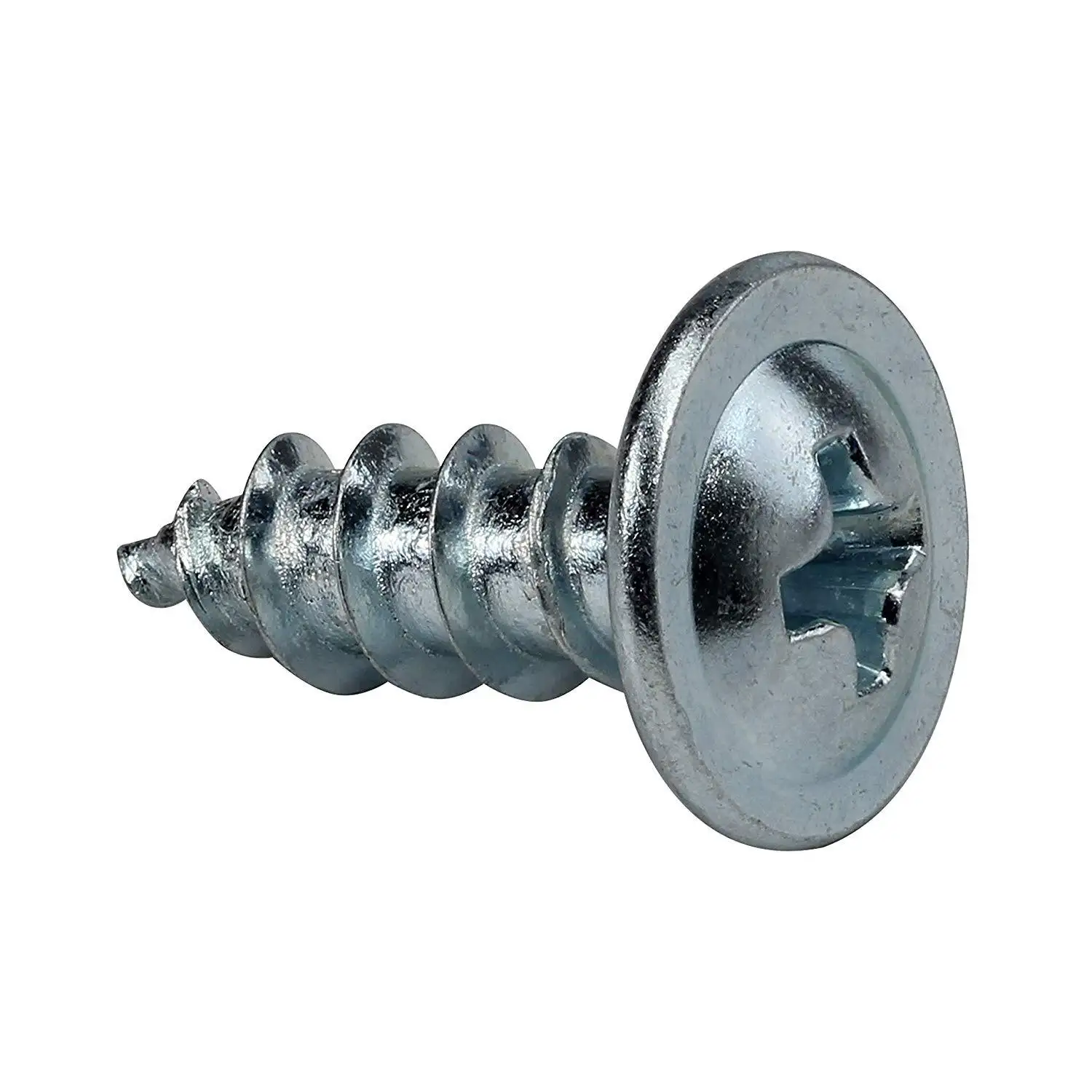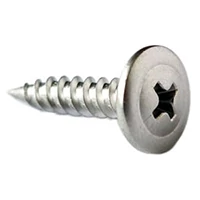TRUSS HEAD SELF DRILLING SCREW
Truss head self-tapping screw is a special type of self-tapping screw. Its head is shaped like a truss structure, and usually has a plurality of raised edges. This design makes the surface area of the head relatively large. Compared with common pan head or countersunk head tapping screws, truss head can provide more uniform pressure distribution during tightening.
Good anti-loosening ability: after the truss head self-tapping screw is tightened, due to the special shape of the head, the friction between it and the connected material is large. In an environment with vibration, such as the fixing of the shell of electronic equipment or the installation of automobile interior, this friction can effectively resist the loosening trend caused by vibration.
High torque transmission efficiency: the shape of the truss head is beneficial for tools such as wrenches or screwdrivers to apply torque. A plurality of edges can provide a better force point, so that torque can be transmitted more effectively in the tightening process, so that the screw can better drive into the material.
Friendly to soft materials: For soft materials, such as foam plastics, soft rubber, etc., truss head self-tapping screw can be fastened without damaging the material. Because the pressure on the head is scattered over a large area, it will not easily cut into soft materials like ordinary sharp-headed screws, resulting in material fracture. In furniture manufacturing, when soft cushion materials need to be fixed on wooden frames, truss head self-tapping screws are a good choice.
-

Truss Head Self Drilling Screw are commonly used to attach cabinets to steel studs. They are also used in applications requiring low clearance above the head. Finally, Truss Head Tek Screw are used to assemble metal parts that will be used in humid environments.
-

Truss Head Self Drilling Screw are commonly used to attach cabinets to steel studs. They are also used in applications requiring low clearance above the head. Finally, Truss Head Tek Screw are used to assemble metal parts that will be used in humid environments.
-

Self-tapping screws have various names. They’re often called metal screws, sheet metal screws, tapping screws, or tapper screws. Their tips come in different shapes: pointed (like a pencil), blunt, or flat, and they are described as thread-forming, thread-cutting, or thread rolling. If the screw is pointed, it will be thread-cutting – tapping and creating threads in a pre-drilled hole. If the tip is flat, it is thread-rolling – rolling or extruding threads and creating zero clearance between screw and material.
Application Scenario of Truss Head Self-Tapping Screw
Electronic equipment field
In the assembly of electronic equipment such as computer case and mobile phone shell, truss head self-tapping screws are used to fix the shell and internal circuit board. Because electronic equipment requires high stability and anti-looseness, and there are many precise electronic components inside, truss head self-tapping screws can realize firm connection without damaging these components, and ensure the stability of electronic equipment in normal use and transportation.
Architectural decoration field
In architectural decoration, it is used to fix some decorative plates, such as plastic gusset plates and wooden decorative lines. The head of the self-tapping screw of the truss head can be in good contact with the surface of the decorative plate, which will not cause surface depression or damage, and can provide sufficient fastening force to make the decorative plate firmly installed on the wall or ceiling.
Automobile manufacturing field
In addition to the interior installation mentioned above, it is also used in the fixing of some non-critical external parts of automobiles. For example, for the installation of plastic bumpers, fenders and other parts of automobiles, truss head self-tapping screws can provide a good connection effect, and at the same time can resist external shocks and vibrations to a certain extent.
What Is the Effect of Different Tightening Torques on the Connection Strength of Truss Head Self-Tapping Screws?
Tightening torque refers to the rotational torque applied when tightening screws. When installing the truss head self-tapping screws, proper tightening torque can ensure the firm combination between the screws and the connecting materials and prevent them from loosening or peeling. Too small or too large tightening torque will affect the strength and performance of the connection. When using self-tapping screws for truss head, tightening torque is an important factor affecting its connection strength and performance.
Influence of Insufficient Torque on Truss Head Self-Tapping Screws
Risk of loose connection
When the tightening torque is insufficient, the truss head self-tapping screw cannot fully penetrate into the connected material, and the degree of engagement between the thread and the material is shallow. For example, when connecting wooden furniture parts, if the torque is not enough, the screws may only be shallowly embedded in the wood, and when the furniture is subjected to slight external force (such as moving and collision in daily use), it is easy to loose. This is because the connection is not tight due to insufficient torque, which makes the friction at the connection part insufficient to resist the loosening trend caused by external force.
Decrease of bearing capacity
For the connection structure subjected to axial tension or shear force, the bearing capacity of truss head self-tapping screws will be greatly reduced due to insufficient torque. In the field of construction, if the truss head self-tapping screws are used to fix the color steel plate, when the torque is insufficient, the screws are easily pulled out of the color steel plate or relatively displaced under the action of external forces such as wind load. Because there is not enough torque to make the screw firmly anchor, its ability to resist axial tension (such as upward tension generated by wind) and shear force (such as horizontal force generated by wind blowing colored steel plate) will be obviously weakened.
Influence of Proper Torque on Truss Head Self-Tapping Screw
Good connection stability
When proper tightening torque is applied, the truss head self-tapping screw can be closely combined with the connected material. Its thread will be deeply embedded in the material, forming a good mechanical bite. For example, in the fixing of the shell of electronic equipment, proper torque can make truss head self-tapping screw closely fit the shell, and at the same time, the thread of the screw firmly engages with the bracket structure inside the equipment. This tight connection can effectively resist external forces such as vibration and collision during transportation and maintain the stability of the connection.
The best carrying capacity is exerted.
Under proper torque, the truss head self-tapping screw can give full play to its bearing capacity. In automobile manufacturing, the truss head self-tapping screws used to fix interior parts can bear all kinds of forces (such as pulling and collision) caused by people's activities in the car and the forces caused by vehicle vibration when the car is running after being tightened with proper torque. At this time, the bearing capacity of axial tension and shear force of the screw can reach a good level, ensuring the firm connection of the interior parts.
Influence of Excessive Torque on Truss Head Self-Tapping Screw
Risk of material damage
Excessive torque may cause damage to the connected materials. For soft materials, such as plastic or thin aluminum plate, it may lead to material deformation and fracture. In the assembly of electronic products with plastic case, if the torque is too large, cracks may appear in the plastic case, which will not only affect the appearance of the product, but also reduce the reliability of the connection. For composite materials, excessive torque may destroy the internal fiber structure, thus affecting the properties and connection strength of the materials.
Risk of damage to screws themselves
At the same time, excessive torque may also cause damage to the truss head self-tapping screw. The head of the screw may be twisted, for example, the edge of the truss head is deformed, which makes subsequent disassembly or maintenance difficult. Moreover, excessive torque may damage the threaded part of the screw, and in some extreme cases, the thread may be broken, making the whole connection invalid. In addition, for some screws with surface treatment (such as zinc plating and chromium plating), excessive torque may destroy the surface coating and reduce the corrosion resistance of the screws.



